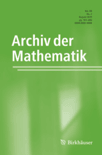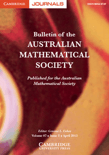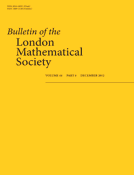
International Journal of Group Theory
Scope & Guideline
Pioneering Research in Group Theory Applications
Introduction
Aims and Scopes
- Group Structure and Classification:
The journal emphasizes the study of group structures, including classifications of finite and infinite groups, subgroup lattices, and properties of specific types of groups such as nilpotent and solvable groups. - Applications of Group Theory:
Research exploring the applications of group theory in areas such as cryptography, signal processing, and quantum information is a significant focus, highlighting the practical implications of abstract mathematical concepts. - Graph Theory and Group Interactions:
The intersection of graph theory and group theory is frequently explored, particularly in relation to the representation of groups through graphs, automorphism groups, and the combinatorial properties of groups. - Algebraic Structures and Constructions:
The journal also covers various algebraic constructions associated with groups, including semigroups, braces, and other algebraic entities, emphasizing their structural properties and relationships. - Computational Aspects:
There is a notable focus on computational aspects of group theory, including algorithms for computing group properties, representations, and automorphisms, showcasing the intersection of mathematics and computer science.
Trending and Emerging
- Cryptography and Security:
There is a growing trend towards exploring group-theoretical applications in cryptography, particularly in the design of secure encryption methods, as researchers recognize the importance of group structures in ensuring data security. - Quantum Computing Applications:
Emerging research related to quantum computing and its connections with group theory is on the rise, highlighting the relevance of algebraic structures in understanding quantum phenomena and developing quantum algorithms. - Computational Group Theory:
An increasing number of papers focus on computational methods within group theory, including algorithm development for group computations and automorphisms, reflecting the integration of computational techniques in theoretical research. - Interdisciplinary Approaches:
Themes that bridge group theory with other mathematical disciplines, such as topology, geometry, and combinatorics, are gaining traction, fostering a more collaborative and integrative research environment. - Advanced Algebraic Structures:
Research on advanced algebraic structures related to groups, including semigroups and braces, is becoming more prevalent, indicating a shift towards exploring new frameworks that extend classical group theory.
Declining or Waning
- Historical Perspectives in Group Theory:
There has been a noticeable decrease in papers focusing on historical developments or classical results within group theory, as the community shifts towards more contemporary applications and computational advancements. - Elementary Group Theory:
Research centered on basic or introductory aspects of group theory appears to be less prominent, with fewer publications addressing fundamental definitions or properties, possibly due to a growing expectation for foundational knowledge among researchers. - Purely Theoretical Constructs:
Themes that involve purely theoretical constructs without practical applications seem to be waning, as the journal increasingly emphasizes research that demonstrates the applicability of group theory in real-world contexts. - Generalized Group Properties:
Studies that focus on very generalized or abstract properties of groups without specific applications or connections to other mathematical areas have seen a decline, indicating a preference for more targeted investigations.
Similar Journals

Mediterranean Journal of Mathematics
Connecting Scholars Through High-Quality Mathematical ResearchThe Mediterranean Journal of Mathematics, published by SPRINGER BASEL AG, is a prominent platform dedicated to the advancement of mathematical research and education. Since its inception in 2004, this journal has been pivotal in disseminating high-quality research across various fields of mathematics, currently holding a notable Q2 ranking in the miscellaneous mathematics category as of 2023. With its ISSN 1660-5446 and E-ISSN 1660-5454, the journal enjoys a respected position in the academic community, evident by its Scopus rank of 129 out of 399 in General Mathematics, placing it in the 67th percentile. While primarily a subscription-based journal, it remains committed to providing a comprehensive resource for researchers, professionals, and students, fostering dialogue and exploration within the mathematical sciences. The Mediterranean Journal of Mathematics, based in Basel, Switzerland, continues to contribute significantly to the evolution of mathematical theory and practice, marking its relevance as we approach its 20th anniversary in 2024.

ARCHIV DER MATHEMATIK
Shaping the Future of Mathematics with Every PublicationARCHIV DER MATHEMATIK is a distinguished journal published by SPRINGER BASEL AG, renowned for its contributions to the field of mathematics. Established in 1948 and continuing its legacy through to 2024, the journal provides a platform for innovative research and scholarly articles that push the boundaries of mathematical theory and application. With an ISSN of 0003-889X and an E-ISSN of 1420-8938, it holds a reputable position within the academic community, reflected by its Q2 ranking in the 2023 Mathematics (Miscellaneous) category. Despite not being an open access publication, ARCHIV DER MATHEMATIK remains accessible to a global audience through various databases, ensuring the dissemination of high-quality research. The journal’s commitment to enhancing mathematical discourse makes it an essential resource for researchers, professionals, and students seeking to expand their understanding of this vital discipline.

BULLETIN OF THE AUSTRALIAN MATHEMATICAL SOCIETY
Navigating Complexities: Your Gateway to Mathematical InsightsBULLETIN OF THE AUSTRALIAN MATHEMATICAL SOCIETY is an esteemed journal dedicated to advancing the field of mathematics, published by Cambridge University Press. Since its inception in 1969, this periodical has fostered scholarly communication and showcased pivotal research in various domains of mathematics, now projected to continue until 2024. With an impact factor that places it in the Q2 category of miscellaneous mathematics research, it holds a notable position among its peers, ranking 215th out of 399 in the Scopus database. Though it does not currently offer open access options, the journal remains a vital resource for researchers, professionals, and students seeking to deepen their understanding of mathematical advancements. The Bulletin serves as a crucial platform for disseminating original research, comprehensive reviews, and insightful perspectives that navigate the complexities of mathematics today, ensuring the community is well-informed and engaged.

RICERCHE DI MATEMATICA
Advancing Knowledge at the Intersection of Theory and ApplicationRICERCHE DI MATEMATICA, published by SPRINGER-VERLAG ITALIA SRL, is a prominent academic journal situated at the intersection of mathematics and its applications, with an ISSN of 0035-5038 and an E-ISSN of 1827-3491. Based in Italy, this journal serves as a crucial platform for disseminating innovative research findings and theoretical advancements in the diverse fields of applied mathematics and general mathematics, currently ranked in the Q3 quartile as per the 2023 category evaluations. The journal's standing is underlined by its impressive Scopus rankings, securing the 61st position out of 399 in General Mathematics and the 224th in Applied Mathematics, placing it well within the 84th and 64th percentiles respectively. Catering to a global audience of researchers, professionals, and students, RICERCHE DI MATEMATICA not only celebrates mathematical exploration but also enhances understanding through open discourse by fostering connections among scholars from various mathematical disciplines. With a converged publication cycle spanning from 2007 to 2024, the journal is committed to promoting high-quality research that shapes the future of mathematical sciences.

Documenta Mathematica
Pioneering Insights in Mathematics Since 1996Documenta Mathematica is a premier academic journal published by the European Mathematical Society (EMS), making significant contributions to the field of mathematics since its inception. With an Open Access model established in 1996, the journal ensures that scholarly works are freely available to a global audience, promoting widespread dissemination of mathematical research. Based in Germany, it serves as a vital platform for mathematicians, covering a wide array of topics within the discipline, evidenced by its impressive Q1 ranking in the miscellaneous category of mathematics as of 2023. Featuring rigorous peer-reviewed articles that span the latest trends and breakthroughs in the discipline, Documenta Mathematica also retains a commendable position among its peers with a Scopus rank of 163 out of 399, placing it in the 59th percentile for general mathematics. Researchers, professionals, and students alike will benefit from the robust scholarly content and the journal's commitment to advancing mathematical knowledge.

BULLETIN OF THE LONDON MATHEMATICAL SOCIETY
Exploring Innovative Research in MathematicsThe BULLETIN OF THE LONDON MATHEMATICAL SOCIETY, published by Wiley, is a distinguished journal that serves as a vital resource in the field of mathematics. With its ISSN 0024-6093 and E-ISSN 1469-2120, this journal has consistently provided a platform for innovative research and scholarly discourse since its inception in 1969. Recognized for its quality, it currently holds an impressive Q1 ranking in the mathematics category, a testament to its significance in disseminating influential findings and trends in the mathematical sciences. Researchers and practitioners can rely on the BULLETIN for its comprehensive coverage of both theoretical and applied mathematics, which caters to a diverse audience ranging from professionals to students alike. Though it does not currently offer Open Access options, its articles can be accessed through institutional subscriptions, ensuring that significant works reach the academic community effectively. With contributions that span over five decades, the journal continues to shape mathematical research and inspire future advancements in the discipline.

Algebra And Discrete Mathematics
Innovative Insights in Algebra and Discrete MathematicsAlgebra And Discrete Mathematics, published by LUHANSK TARAS SHEVCHENKO NATIONAL UNIVERSITY, is a pivotal academic journal dedicated to exploring the realms of algebra and discrete mathematics. Since its inception in 2012, this journal has contributed significantly to the mathematical community, catering to researchers, professionals, and students interested in advancing their understanding of both classical and contemporary mathematical theories. With categories placed in Q4 in Algebra and Number Theory and Q3 in Discrete Mathematics and Combinatorics, and rankings that place it among various domains with percentiles reflecting its niche status, the journal offers a platform for innovative and high-quality research. While the journal is currently not open access, it maintains a robust academic presence, and its continuous publication until 2024 ensures a steady stream of scholarly discourse. Researchers and academics keen on disseminating their findings or keeping abreast of the latest developments in these mathematical fields will find valuable insights and diverse methodologies within its pages.

Advances in Mathematics of Communications
Pioneering Connections in Mathematical CommunicationAdvances in Mathematics of Communications, published by the American Institute of Mathematical Sciences (AIMS), is a leading journal dedicated to the dissemination of high-quality research in the fields of algebra, number theory, applied mathematics, discrete mathematics, combinatorics, and computer networks. Established in 2008, this journal has quickly established itself as a significant contributor to mathematical communications, holding a reputable position in the Scopus rankings, with impressive category quartiles, including Q2 rankings in key areas such as Algebra and Number Theory and Applied Mathematics. Besides its rigorous peer-review process, the journal facilitates the growth of innovative ideas and methodologies that bridge the gap between theory and application. With no open access restrictions, Advances in Mathematics of Communications aims to provide an inclusive platform for researchers, professionals, and students to share their findings and insights, fostering collaboration and advancing the global knowledge base in the mathematical sciences. The journal's commitment to excellence ensures its role as an essential resource in the ever-evolving landscape of mathematics.

RENDICONTI DEL SEMINARIO MATEMATICO DELLA UNIVERSITA DI PADOVA
Innovative research shaping the future of mathematical disciplines.RENDICONTI DEL SEMINARIO MATEMATICO DELLA UNIVERSITA DI PADOVA, published by the European Mathematical Society, stands as a notable open-access journal with a rich history in disseminating research across various domains of mathematics. With an ISSN of 0041-8994 and E-ISSN 2240-2926, this journal has embraced open access since 2023, significantly enhancing its visibility and accessibility to a global audience. Situated in Germany, its publishing house is based at Technical University Berlin, which emphasizes its academic roots and dedication to fostering mathematical research. The journal features a quartile ranking of Q3 across multiple categories including Algebra and Number Theory, Analysis, Geometry and Topology, and Mathematical Physics as of 2023, indicating a vibrant contribution to the field, despite its challenge in specific rankings. Researchers, professionals, and students alike will find in this journal a platform for innovative ideas and significant findings that are crucial to the evolution of modern mathematics.

International Electronic Journal of Algebra
Transforming Algebra: Sharing Knowledge Without BoundariesThe International Electronic Journal of Algebra (IEJA) is a premier open-access platform dedicated to advancing research in the field of algebra and number theory. Established in Turkey and published by IEJA-INT ELECTRONIC JOURNAL ALGEBRA, this journal has been providing unrestricted access to high-quality scholarly articles since 2007, facilitating the dissemination of valuable findings and innovative methodologies to a global audience. With an ISSN of 1306-6048 and a notable Scopus rank of 85 out of 119 in its category, IEJA contributes significantly to the mathematical community, evidenced by its Q3 quartile ranking in Algebra and Number Theory as of 2023. Researchers, professionals, and students can engage with a diverse range of topics in algebra, enhancing both theoretical understanding and practical applications in this vital area of mathematics. As a journal committed to fostering collaboration and progress, IEJA stands out as an essential resource for anyone seeking to contribute to and learn from the evolving discourse in algebra.